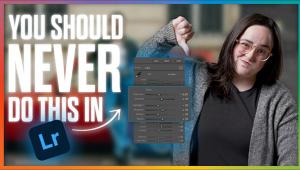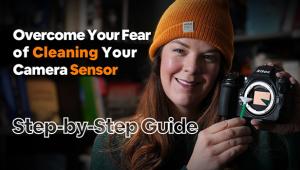PhotoVision’s One Shot Digital Calibration Targets; White Balance And Exposure, Right In The Camera Page 3
 |
|
|
How To Use The One Shot Digital Calibration Target
My experience is based on using the target with Canon D-SLRs (EOS 5D and 20D).
Imaging sensor sensitivity patterns and Custom WB procedures vary with manufacturer
and possibly with camera model, so follow instructions outlined in your camera's
Owners Manual. I've sketched out a broad-based approach, which may need
to be tailored to fit your circumstances. Whatever camera you use, you will
need to display a histogram during playback/review to determine the best image
to use for Custom WB and exposure settings.
1. Positioning the One Shot Digital Calibration Target.
Place it so that the white patch is on the same side as the main light,
making sure the target faces the camera but angled ever so slightly in the direction
of the key light, keeping the target upright. This ensures an accurate white
point reading, which we'll need at the next stage. If skylight or ceiling
bounce light is the main light, position the white patch at the top. With portraits,
have the subject hold the target in front of their face. With other subjects,
place the target as close to the subject as possible.
2. Determining exposure. You can make the
initial exposure with the camera's meter or an incident meter. When adding
the calibration target, fill the frame as much as possible with the target,
aiming the lens at the target's crosshairs on the gray patch, and make
the exposure.
a. When using an incident meter (outdoors or with studio lighting),
take a reading from the subject position to determine the optimum exposure and
white balance. Set the camera to Manual Shooting mode and, using the exposure
derived from the incident meter reading, take a picture of the target. Check
the histogram on the camera to evaluate the exposure (see Step 3). (Alternatively,
you can take a handheld reflectance meter reading off the gray patch. Then follow
the steps outlined.)
b. When using the camera's TTL metering in any Autoexposure
mode, first reset exposure compensation to the null point (centered on the scale).
Next set the camera's TTL metering pattern to multi-pattern (or evaluative
or matrix) metering and read the exposure off the target. If necessary, hold
the target at arm's length, provided subject and target are under the
same light, again filling the frame and focusing on the crosshairs. Bracket
in 1¼3 or 1¼2 stops above and below the metered exposure up to
+/- 1 stop (or thereabouts). Once the optimum exposure has been determined,
check the histogram (see Step 3), set the camera to Manual mode; set the f/stop
and shutter speed based on that initial reading, keeping flash sync in mind
where applicable.
c. When using TTL or auto-thyristor flash, set the flash to
Manual mode (for consistent output) before making any test shots with the calibration
target.
3. Setting Custom WB. This procedure may vary with camera model.
With my Canon EOS 5D, I begin by setting white balance to Auto WB (or you can
start in Custom WB). After making the initial exposure, which targets the gray
patch, I read the histogram on the camera. I check that the black and white
points are fairly the same distance from the edge of the frame, with gray peaking
in the middle. I then set Custom WB keyed to the exposure that appears optimum
for this situation. (If you've bracketed, you may have to review the images
to find the optimum exposure.) You now have not only the white balance tailored
to the situation, but, thanks to the black (shadow) and white (highlight) points,
you also have an optimum tonal range for the subsequent exposures. Don't
worry if the histograms for the actual subject look nothing like the calibration
histograms. The histogram for a low-key image would lean more to the left, the
shadow side, and a high-key histogram would exhibit a highlight bias on the
right.
a. Note: following the Expose to the Right rule, it might benefit
the shadow values if you push the histogram slightly to the right by 1/3 or
1/2 stop--in other words, overexposing just a bit, provided this step does
not blow out the highlights. During raw conversion or when editing the image,
bring the exposure back down to the optimum level. This practically eliminates
digital noise in the darker regions of the picture.
4. Shoot a second reference image of the target at the established
exposure and Custom WB settings (optional, but I like to take this step just
to confirm that I nailed it). Now turn your attention to the subject, leaving
all the guesswork behind.
Availability And Info
The One Shot Digital Calibration Targets are available from PhotoVision online
at www.photovisionvideo.com,
or by calling (888) 880-1441. The website also provides online tutorials, although
a comprehensive tutorial DVD comes with each target, with tips on using Adobe's
Lightroom.
- Log in or register to post comments

































